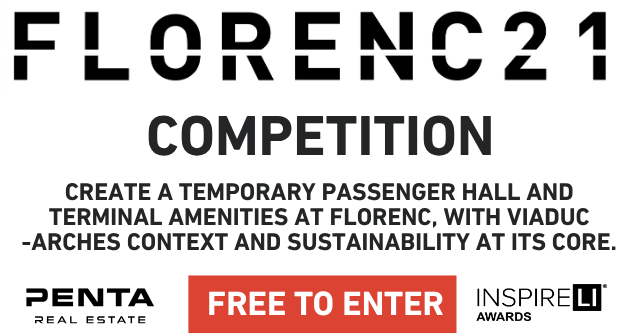Croatian Cultural Centre in Jarovce, Slovakia
Idea projektu
Projekt reaguje na kontrast medzi historickou líniovou zástavbou a novšou rozptýlenou zástavbou v Jarovciach. Navrhuje kultúrne centrum, ktoré slúži ako most medzi starým a novým, a to fyzicky aj symbolicky. Architektonický koncept je založený na otvorenosti, transparentnosti a prepojení komunity s kultúrou ako jednotiacim prvkom. Budova je priepustná zo všetkých strán s vnútorným usporiadaním v tvare kríža, ktoré podporuje pohyb medzi kľúčovými verejnými priestormi v oblasti. Formálne návrh reinterpretuje archetyp tradičného domu so šikmou strechou na súčasnú minimalistickú štruktúru s priesvitnou textilnou fasádou, ktorá symbolizuje ľahkosť a otvorenosť. Projekt sa vyhýba folklórnemu stvárneniu chorvátskej identity a namiesto toho sa zameriava na univerzálne hodnoty: inkluzívnosť, spoluprácu a spoločnú kultúru. Stáva sa priestorom, kde sa stretávajú komunity, príbehy a identity - vyjadrením toho, ako sa usilujeme žiť spoločne, s rešpektom k dedičstvu aj budúcnosti.
Popis projektu
Návrh odráža prechodný charakter lokality, ktorá sa nachádza medzi historickým jadrom Jaroviec a ich novšou zástavbou. Zatiaľ čo staršia mestská štruktúra sa vyznačuje štruktúrovaným usporiadaním ulíc a úzkymi parcelami, novšie územie je rozptýlenejšie a charakterizujú ho voľne stojace budovy. Kultúrne centrum je strategicky umiestnené tak, aby prepájalo okolité obytné zóny, športové zariadenia, cintorín a centrum obce. Otvorená forma budovy a viaceré vstupy podporujú jej priechodnosť a vytvárajú z nej dynamické centrum života obce. Pôdorys v tvare kríža umožňuje flexibilné usporiadanie interiéru a priamy peší tok cez budovu, čím ju plynulo integruje s okolím. Vonkajšie priestory plynule prechádzajú do interiéru, čím podporujú neformálne stretnutia a verejné podujatia. Terénne úpravy a spevnené plochy sú navrhnuté tak, aby odrážali mierku a rytmus okolitej štvrte a zároveň zabezpečovali prístupnosť pre všetkých užívateľov. Z architektonického hľadiska je budova definovaná priesvitnou textilnou fasádou, ktorá zjemňuje jej hmotu a zdôrazňuje jej občiansku úlohu. Mierne naklonené tieniace panely inšpirované tradičnými sedlovými strechami dodávajú exteriéru rytmus a zároveň evokujú motívy otvorenosti a ľahkosti. Prízemie rozmiestňuje programové zóny v každom zo štyroch rohov budovy. Hlavný vstup z Ovocnej ulice vedie do dvojvýškového foyer s informačným bodom a svetlíkom. Kaviareň s výhľadom do dažďovej záhrady zaberá roh orientovaný k cintorínu. Schodisko vedie na horné poschodie, kde sa nachádza verejná knižnica a čitáreň. K informačnému bodu priliehajú spoločné toalety a viacúčelová sála situovaná v juhovýchodnom rohu. Táto sála sa otvára do vonkajšieho priestoru so sedením v štýle amfiteátra, čím sa vytvára komorné miesto na vystúpenia a verejné podujatia. Podporné priestory zahŕňajú šatne, stravovacie zariadenia a zázemie pre personál. Parkovanie a prístup pre služby sa nachádzajú v zadnej časti areálu, cez novo rozšírenú cestu. Flexibilný pôdorys umožňuje širokú škálu aktivít, od koncertov a výstav až po prednášky a workshopy. Na hornom poschodí sa nachádza aj dielňa/joga s vlastným sociálnym zariadením a terasou spolu s ďalším zázemím pre návštevníkov.
Technické informácie
Konštrukčný systém má šesťmetrový raster a je realizovaný technológiou Peikko: železobetónové stĺpy sú spojené s prefabrikovanými filigránovými stropnými doskami. Technické inštalácie prebiehajú pod stropom a sú diskrétne ukryté akustickými panelmi. Presklené časti fasády sú zatienené ľahkým štruktúrovaným textilným plášťom, ktorý nielen filtruje slnečné svetlo, ale aj vizuálne zdôrazňuje modulárny rytmus architektúry. Budova uprednostňuje pasívne stratégie chladenia inšpirované tradičnými stavebnými technikami. Primárnou obranou proti prehrievaniu je vonkajšia textilná tieniaca vrstva, ktorá v kombinácii s bielou vetranou fasádou minimalizuje absorpciu slnečného tepla. Kľúčovú úlohu zohráva prirodzené vetranie - ovládateľný svetlík na vrchole strechy aktivuje komínový efekt, ktorý umožňuje únik teplého vzduchu z horných úrovní budovy. Pokiaľ ide o aktívne systémy, budova obsahuje stropné chladenie zabudované v monolitickej železobetónovej doske, ktorá zároveň funguje ako sálavé vykurovanie. Na zvýšenie tepelného komfortu sú pozdĺž presklených fasád nainštalované podlahové konvektory s integrovanými elektrickými ventilátormi, ktoré účinne zabraňujú studenému prievanu a kondenzácii. Celý systém je napájaný tepelným čerpadlom voda-voda umiestneným v technickej miestnosti na druhom poschodí, ktoré čerpá geotermálnu energiu zo systému studní. Strecha je navrhnutá ako extenzívna zelená strecha - skutočná "piata fasáda" - poskytujúca ekologické výhody aj vizuálnu príťažlivosť. Prebytočná dažďová voda je riadená prostredníctvom retenčnej nádrže umiestnenej v priľahlej dažďovej záhrade v blízkosti cintorína.
Projekt odovzdaný
16. 06. 2025Štítok
Rady študentom


